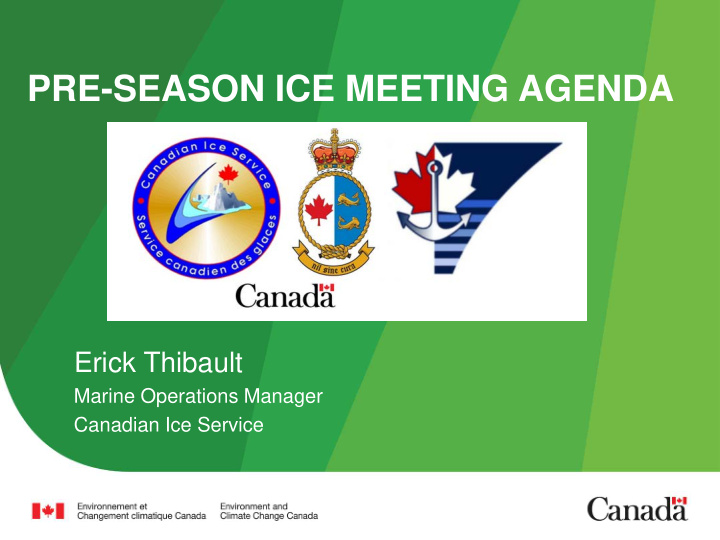



PRE-SEASON ICE MEETING AGENDA Erick Thibault Marine Operations Manager Canadian Ice Service
The Canadian Ice Service , is a division of the Meteorological Service of Canada , is the leading authority for ice and iceberg information in Canada's navigable waters.
The Canadian Ice Service's mission is to provide the most accurate and timely information on ice and icebergs in Canada's navigable waters.
Our mandate is broad and of paramount importance. Part of the Canadian economy depends on the accuracy of our data Sometimes lives are at stake
ISS Roles and Responsibilities The ISS is a bridge between CIS, the GGC and other Stakeholders... He represents CIS in the Ice Office and on board ships, but he is also the GGC's spokesperson to CIS
Short history of the Ice Services (Forecast side) • 1954 - Dew Line Launch of the HMCS Labrador (First built for CCG) • Spring 1958 - inauguration of the first Canadian ice forecast office – Sea Ice Central - at HMCS Shearwater (Halifax) • End of 1958 - Transfer to the Department of Transport • 1971 - Relocation to Ottawa
Short history of the Ice Reconnaissance Division • 1957 - Ice Reconnaissance Division was set • Responsible for collection of most of the ice data used by the Ice Central for its forecast • Gathered from aerial reconnaissance (fixed wing and helicopter) flights, and by ice observers assigned to CCG icebreakers. • Training of new ice observers was also the responsibility of this Division. • Involved in a Working Group for international standard of ice terminology with the WMO ( World Meteorological Organization )
Short history of the Ice Reconnaissance Division • The Canadian Ice Service submitted a method to portray the ice data on transmitted charts. Tested and accepted by most of the countries where ice covered waters • interfered with commercial shipping , fishing and other marine operations. The EGG Code
Ice Reconnaissance Division NOWADAYS…. • Became the Ice Field Services • Still working from various plateforms • Working in CCG facilities • Involved in various National Defense Projects • Involved in Shipping Assistance • Still responsible for the training of new ice observers within a new training program (APTP-ICE)
Ice Field Services is…. • 8 Active ISS in the field and / or offices • 9 Trainees actually under APTP-ICE in La Place Bonaventure • Expecting being full staff by Janurary 2021 • Expecting a new round of trainnees by 2022
Ice Field Services tools… • Specialized Softwares: • ICEggs • ICEvu • Ninjo (Weather software) • Satellite imagery (provided by Ice operation in Ottawa) • Radasat 2 • Modis • Sentinel • Radarsat Constellation (Soon) • Ottawa Operation • Daily ice chart • Ice Forecast • Briefing • Ships Report
The tools ISS uses Share the info!!! Visual mapping ICEggs
Ice Field Services / CCG Products… • Ice observation Charts • Ice Bulletins • St. Lawrence River • St. Lawrence Gulf • Atlantic waters • Artic • Great Lakes • Weather and Ice Briefings to: • CCG • Industry • Public • Ice routing ( with CCG nav officers ) • Gulf recommended route • Specific route for shipping
Where to get the Products… • CCG website MARINFO https://www.marinfo.gc.ca/
This being said….. Go back to the ICE code... The Eggs and the COLOR CODE Let’s compare…
WMO Two daily charts for the area…. Be careful with the interpretation…
WMO Colour Code for Stage of Development • The WMO colour code for stage of development is an international code that is intended for use when the concentration is relatively uniform, but the stage of development is highly variable (e.g. Atlantic winter). • No colours are used to indicate differences in the concentration of the ice.
WMO Colour Code for Stage of Development
WMO Colour Code for Concentration • The WMO colour code for total concentration is an international code that is intended for use when the stage of development is relatively uniform, but concentrations are highly variable (e.g. arctic summer). • No colours are used to indicate differences in the ice stage of development.
WMO Colour Code for Concentration
Standard CIS/CCG Colour Code • The Standard CIS Colour code is intended to assist navigation decisions in ice infested waters. • It represents the severity of the ice conditions and is somewhat similar to a traffic light. • Colours are used to identify ice concentrations of significant ice.
Standard CIS/CCG Colour Code
Each partners has a role
That is of what I call: Mutualism Accuracy will be improved It is an interaction between two species, in which the organisms involved both benefit from this relationship. This is referred to as a mutually beneficial interaction.
… et construirons des ponts Let’s work together
Thank you
… et construirons des ponts Let’s work together
Recommend
More recommend